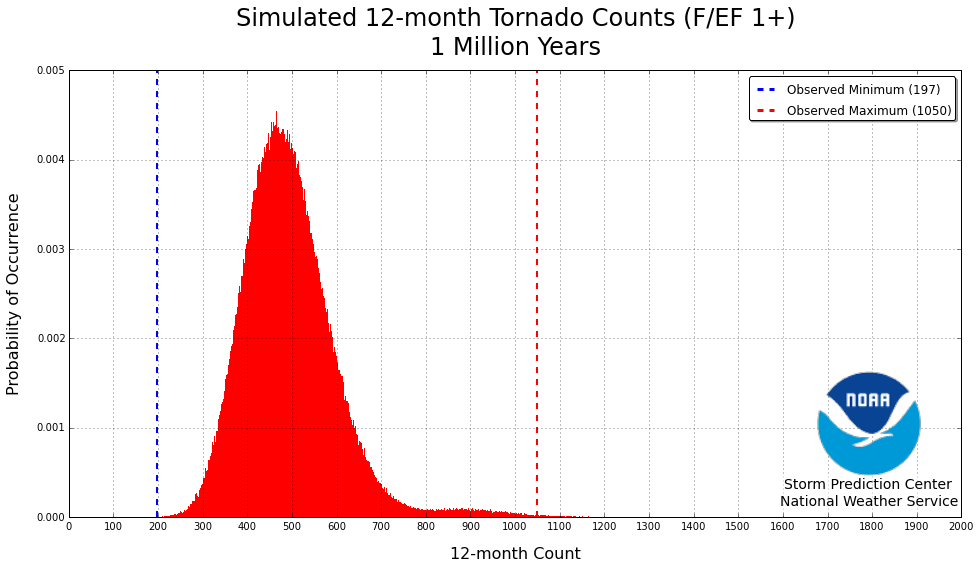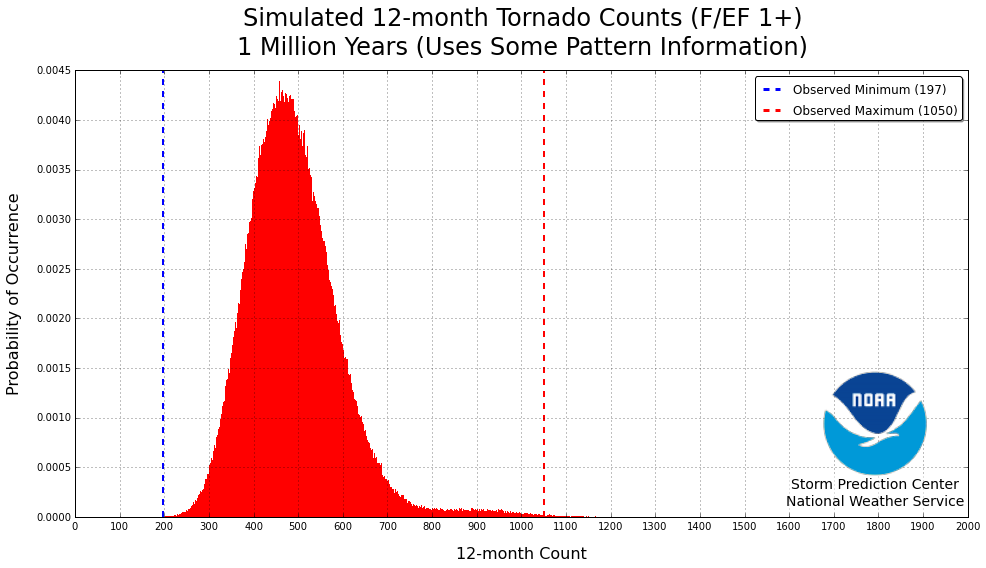Anyone who is interested in severe convective weather is probably aware of the current tornado drought. For those who are unaware, this refers to the 12-months from May 2012 through April 2013 having the fewest number of (preliminary) F/EF-1 or stronger tornado reports of any 12-month period in the official tornado record. This follows on the heels of the 12-month period of June 2010 through May 2011 as having the most number of F/EF-1 or stronger tornado reports of any 12-month period. The question I wanted to know was, how rare of an event are each of those?
To determine the answer I conducted a little data experiment. I calculated the number of tornadoes of strength F/EF-1 or stronger that occurred in each month of the year for the years 1954 through 2012. (No 2013 data are used in the following calculations.) Thus, I had 59 January counts, 59 February counts, ..., 59 December counts. For each month I randomly selected a count from that month's distribution. I then summed each of those twelve randomly determined counts to create a randomly generated yearly count. Note, each month only contributed to the year once. I then repeated this process for a total of 1 million randomly generated yearly tornado counts. The minimum number of yearly tornadoes was 149, with 1332 the maximum. The distribution of these 1 million yearly tornado counts is shown below:
The distribution is plotted in color-filled red. Additionally, the current tornado "drought" is shown via the blue dashed line (197 F/EF-1 or stronger tornadoes) and the previous tornado "surplus" is shown via the red dashed line (1050 F/EF-1 or stronger tornadoes). Using the distribution above, we can determine the empirical probability of a given yearly tornado count.
- Simulated Minimum (149) Probability: ~0.0
- Observed Minimum (197) Probability: 0.000018
- Observed Maximum (1050) Probability: 0.999141 (0.000858999999999)
- Simulated Maximum (1332) Probability: ~1.0 (~0.0)
- Return Period for Observed Minimum: 55555.5555556 years.
- Return Period for Observed Maximum: 1164.1443539 years.
As you can see, both the recent drought and the recent surplus are quite anomalous. A yearly tornado drought like the current one would occur once every 55,556 years. A yearly tornado surplus like 2010-2011 would occur once every 1164 years. As you can see the current 12-month tornado drought is a much rarer occurrence.
The model above, however, is rather simple. It does not take into considerations anything along the lines of "being locked in a pattern". What I mean by this is that often times when you are in a below normal tornado month, the next month tends to be below normal as well. In other words, when the pattern gets good or bad, it tends to favor staying good or bad, at least in the short term. At the suggestion of Dr. Harold Brooks of the National Severe Storms Laboratory, I decided to update the model to see if I could include the monthly dependency.
Using the median tornado count for each month as "normal", I determined if a given month's tornado count was above/below/equal normal. I then compared to see if the following month was above/below/equal normal. It turns out that about 52% of the time, the "pattern" remains the same in subsequent months. About 41% of the time the pattern "flips" to the other extreme, and about 7% of the time the pattern either remains or transitions to "normal".
- Number of month transitions: 707.0
- Flip Pattern: 292 (0.413012729844)
- Persist Pattern: 367 (0.51909476662)
- Median: 48 (0.0678925035361)
Using this information, I updated how I randomly generated the yearly counts so that subsequent month's counts were somewhat related to the current month's count. This was done by determining if the current month was above/below/equal to "normal". Then, based on the pattern change information listed above, I used a weight resampling approach to determine if the following month would be above/below/equal to "normal". If the month was "forecast" to be above normal, I randomly chose a monthly count from that month's above median counts. If the month was "forecast" to be below normal, I randomly chose a monthly count from that month's below median counts. If the month was "forecast" to be normal, I randomly chose a monthly count from that month's entire distribution. Again, this is still a simple model, but it does at least attempt to capture inter-monthly dependencies. The minimum number of yearly tornadoes in this updated model was 161, with 1325 the maximum. The updated model distribution is shown below. Although it's extremely hard to differentiate from the previous distribution is is different!
- Simulated Minimum (161) (Probability: ~0
- Observed Minimum (197) Probability: 0.000035
- Observed Maximum (1050) Probability: 0.999062 (0.000937999999999)
- Simulated Maximum (1325) Probability: ~1.0 (~0)
- Return Period for Observed Minimum: 28571.4285714 years.
- Return Period for Observed Maximum: 1066.09808102 years.
As you can see, both the recent drought and the recent surplus are still quite anomalous, although not nearly as much. A yearly tornado drought like the current one would occur once every 28, 571 years. A yearly tornado surplus like 2010-2011 would occur once every 1066 years. As you can see the current 12-month tornado drought is still a much rarer occurrence.
Anyway you look at it, the recent tornado "surplus" and the current tornado "drought" is extremely rare. The fact that we had both of them in the span of a few years is even more so!

